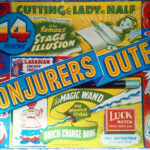I’m very interested in the notion of the (performance) magic(al) object. Aileen Robinson (2014) in ‘“All Transparent”: Pepper’s Ghost, Plate Glass, and Theatrical Transformation’ sees the magic object, in her example it’s a dove, as being transformed into a magical thing by (and at) the very moment of transformation or disappearance. This represents a shift of focus for the observer, and Robinson suggests that objects become magical things through a process transformational enactment, Robinson calls this ‘illusory enactment’ (Robinson, 2014, p. 136).
Robinson extends this discussion to the plate glass covering the stage and facilitating the illusion of the appearance of Pepper’s Ghost. It is this object that becomes the magical thing through its employment in Pepper’s illusion[1]. The plate glass becomes the thing producing the ghost.
However, I suggest that if we look on a more practical level at the standard prop in performance magic, we see that the object also becomes transformed through interaction with a magician through the effect; for example, two individual solid rings become linked, or an egg is transformed into a silk handkerchief. This is the latent and the hidden that pushes up against the ordinariness of the mundane object and makes it magic(k)al. The vase is a normal vase, until the magician does something to it, and it is transformed into a magical thing through an illusory performance that includes a facilitated moment of enactment.
Of course, the props of the magician are themselves extraordinary by the virtue of them being stage properties of a magician, whether the performance of magic then comes from the physical alteration (gimmicking) of that object or that object is made other through the skill or actions of the magician.
Pringle, when discussing 19th century stage illusions, argues that the mechanisms and designs of magic lead to a ‘subliminal awareness of an elsewhere that was not supernatural’ (Pringle, 2002, p. 342). This awareness can be extended to our understanding of magic props. The audience are often aware that the garishly painted box is gimmicked in some way and that the dove does not, and cannot, simply vanish. Therefore, it must have gone somewhere (in Pringle’s terms an ‘elsewhere’). In this model the employment of the conventional magic prop once again becomes a trick, or a puzzle to be solved, rather than a moment of real magic.
In bizarre magick, a genre I am very interested in, the prop or magical object is still a magic prop, however the bizarre magician attempts to remove, or at least dislocate, this notion of a mundane ‘elsewhere’ in favour of alternative elsewhere driven by supernatural causes. In bizarre magick performance the object is often portrayed as a ‘genuine’ magical object and it is frequently central to the conceit of the effect, drawing as it does from a variety of occult or fictional sources. To further remove the notion of ‘elsewhere’ and to make the objects appear real, many works on bizarre magick discuss how to age, customise, and give historical providence to existing or custom magic props. In an early editorial for Invocation, Anthony Raven discusses how to age props so that they ‘look the part and “appear” authentic‘ (Raven, 1974a) and the Negromicon of Masklyn ye Mage was not only a handmade book of effects, but also ‘a prop to use in your shows’ or ‘an unusual book to keep around the house to show your guests’ (Magus, 2011, p. 197).
[1] For discussion on the history and workings of Pepper’s Ghost see; Speaight (1989) & Brooker (2007)
Brooker, J. (2007). The Polytechnic Ghost. Early Popular Visual Culture, 5(2), 189–206.
Magus, J. (2011). UnSpeakable Acts: Three lives and countless legends of Tom Palmer, Tony Andruzzi & Masklyn ye Mage. James Salterella.
Pringle, T. (2002). The Space of Stage Magic: A Study of the Application of Optical, Mechanical, and Psychological Principles in Classic Stage Illusions and Their Possible Relation to 20th-/21st-Century Experiences of Interior Architectural Space. Space and Culture, 5(4), 333–345.
Raven, A. (1974). Leaves from the Black Book. Invocation, 1(2), 22–23.
Robinson, A. (2014). “All Transparent”: Pepper’s Ghost, Plate Glass, and Theatrical Transformation. In M. Schweitzer & J. Zerdy (Eds.), Performing Objects and Theatrical Things (pp. 135–148). Palgrave Macmillan UK.
Speaight, G. (1989). Professor Pepper’s Ghost. Theatre Notebook: A Journal of the History and Technique of the British Theatre, 43(1), 16–16.

Comments by Nik Taylor